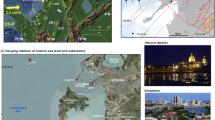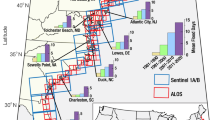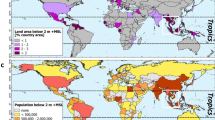Abstract
Coastal land can be lost at rapid rates due to relative sea-level rise (RSLR) resulting from local land subsidence. However, the comparative severity of local land subsidence is unknown due to high spatial variabilities and difficulties reconciling observations across localities. Here we provide self-consistent, high spatial resolution relative local land subsidence (RLLS) velocities derived from Interferometric Synthetic Aperture Radar for the 48 largest coastal cities, which represent 20% of the global urban population. We show that cities experiencing the fastest RLLS are concentrated in Asia. RLLS is also more variable across the 48 cities (−16.2 to 1.1 mm per year) than the Intergovernmental Panel on Climate Change estimations of vertical land motion (−5.2 to 4.9 mm per year). With our standardized method, the identification of relative vulnerabilities to RLLS and comparisons of RSLR effects accounting for RLLS are now possible across cities worldwide. These will better inform sustainable urban planning and future adaptation strategies in coastal cities.
This is a preview of subscription content, access via your institution
Access options
Access Nature and 54 other Nature Portfolio journals
Get Nature+, our best-value online-access subscription
$29.99 / 30 days
cancel any time
Subscribe to this journal
Receive 12 digital issues and online access to articles
$119.00 per year
only $9.92 per issue
Buy this article
- Purchase on Springer Link
- Instant access to full article PDF
Prices may be subject to local taxes which are calculated during checkout




Similar content being viewed by others
Data availability
All replication data of RLLS velocities in this study are available in the following DR-NTU Data repository: https://doi.org/10.21979/N9/GPVX0F. The vertical land motion rates from the IPCC AR6 are publicly available at https://podaac-tools.jpl.nasa.gov/drive/files/misc/web/misc/IPCC/IPCC_AR6_slp_regional.tar.gz. Glacial isostatic adjustment rates from ICE-6G_C (VM5a) is publicly available at https://www.atmosp.physics.utoronto.ca/~peltier/data.php. Plate tectonic boundaries plotted in Fig. 2 are downloadable from https://www.usgs.gov/media/files/plate-boundaries-kmz-file. GNSS velocities plotted in Fig. 4 are downloadable from https://data.lib.vt.edu/articles/dataset/World_s_Coast_Vertical_Land_Motion/17710973. Source data are provided with this paper.
Code availability
All codes for the analysis of the datasets are available in the following DR-NTU Data repository: https://doi.org/10.21979/N9/GPVX0F. ARIA-SG algorithms, which contain ISCE algorithms, are accessible at: https://github.com/earthobservatory. Other InSAR processing algorithms including ARIA-Tools v1.1.1 and MintPy v1.3.0 are open-source and freely available through Github.
References
IPPC Climate Change 2021: The Physical Science Basis (eds Masson-Delmotte, V. et al.) (Cambridge Univ. Press, 2021).
Chaussard, E., Amelung, F., Abidin, H. & Hong, S.-H. Sinking cities in Indonesia: ALOS PALSAR detects rapid subsidence due to groundwater and gas extraction. Remote Sens. Environ. 128, 150–161 (2013).
Raucoules, D. et al. High nonlinear urban ground motion in Manila (Philippines) from 1993 to 2010 observed by DInSAR: implications for sea-level measurement. Remote Sens. Environ. 139, 386–397 (2013).
Aobpaet, A., Cuenca, M. C., Hooper, A. & Trisirisatayawong, I. InSAR time-series analysis of land subsidence in Bangkok, Thailand. Int. J. Remote Sens. 34, 2969–2982 (2013).
Higgins, S. A. Advances in delta-subsidence research using satellite methods. Hydrol. J. 24, 587–600 (2016).
Shirzaei, M. et al. Measuring, modelling and projecting coastal land subsidence. Nat. Rev. Earth Environ. 2, 40–58 (2021).
Ericson, J. P., Vörösmarty, C. J., Dingman, S. L., Ward, L. G. & Meybeck, M. Effective sea-level rise and deltas: causes of change and human dimension implications. Glob. Planet. Change 50, 63–82 (2006).
Syvitski, J. P. et al. Sinking deltas due to human activities. Nat. Geosci. 2, 681–686 (2009).
Dasgupta, S., Laplante, B., Murray, S. & Wheeler, D. Sea-level Rise and Storm Surges: A Comparative Analysis of Impacts in Developing Countries World Bank Policy Research Working Paper (World Bank, 2009).
Hanson, S. et al. A global ranking of port cities with high exposure to climate extremes. Clim. Change 104, 89–111 (2011).
Wiseman, K., Bürgmann, R., Freed, A. M. & Banerjee, P. Viscoelastic relaxation in a heterogeneous Earth following the 2004 Sumatra–Andaman earthquake. Earth Planet. Sci. Lett. 431, 308–317 (2015).
Qiu, Q., Moore, J. D., Barbot, S., Feng, L. & Hill, E. M. Transient rheology of the Sumatran mantle wedge revealed by a decade of great earthquakes. Nat. Commun. 9, 995 (2018).
Love, R. et al. The contribution of glacial isostatic adjustment to projections of sea‐level change along the Atlantic and Gulf coasts of North America. Earth’s Future 4, 440–464 (2016).
Ding, K., Freymueller, J. T., He, P., Wang, Q. & Xu, C. Glacial isostatic adjustment, intraplate strain, and relative sea level changes in the eastern United States. J. Geophys. Res.: Solid Earth 124, 6056–6071 (2019).
Wöppelmann, G. & Marcos, M. Vertical land motion as a key to understanding sea level change and variability. Rev. Geophys. 54, 64–92 (2016).
Zhao, R. et al. Rapid land subsidence in Tianjin, China derived from continuous GPS observations (2010–2019). Proc. Int. Assoc. Hydrological Sci. 382, 241–247 (2020).
Brooks, B. et al. Space geodetic determination of spatial variability in relative sea level change, Los Angeles basin. Geophys. Res. Lett. 34, L01611 (2007).
Abidin, H. Z. et al. in IAG 150 Years: International Association of Geodesy Symposia Vol. 143 (eds Rizos, C. & Willis, P.) 435–442 (Springer, 2015).
Pfeffer, J. & Allemand, P. The key role of vertical land motions in coastal sea level variations: a global synthesis of multisatellite altimetry, tide gauge data and GPS measurements. Earth Planet. Sci. Lett. 439, 39–47 (2016).
Engelhart, S. E., Horton, B. P., Douglas, B. C., Peltier, W. R. & Törnqvist, T. E. Spatial variability of late Holocene and 20th century sea-level rise along the Atlantic coast of the United States. Geology 37, 1115–1118 (2009).
Nicholls, R. J., Hoozemans, F. M. & Marchand, M. Increasing flood risk and wetland losses due to global sea-level rise: regional and global analyses. Glob. Environ. Change 9, S69–S87 (1999).
Nicholls, R. J. et al. A global analysis of subsidence, relative sea-level change and coastal flood exposure. Nat. Clim. Change 11, 338–342 (2021).
Ostanciaux, E., Husson, L., Choblet, G., Robin, C. & Pedoja, K. Present-day trends of vertical ground motion along the coast lines. Earth Sci. Rev. 110, 74–92 (2012).
Nicholls, R. J. & Cazenave, A. Sea-level rise and its impact on coastal zones. Science 328, 1517–1520 (2010).
United Nations, Department of Economic and Social Affairs, Population Division. World Urbanization Prospects: The 2018 Revision (United Nations, 2019).
Fuhrmann, T. & Garthwaite, M. C. Resolving three-dimensional surface motion with InSAR: constraints from multi-geometry data fusion. Remote Sens. 11, 241 (2019).
Rucci, A., Ferretti, A., Guarnieri, A. M. & Rocca, F. Sentinel 1 SAR interferometry applications: the outlook for sub millimeter measurements. Remote Sens. Environ. 120, 156–163 (2012).
Garner, G. G. et al. IPCC AR6 Sea-Level Rise Projections v.20210809 (PO.DAAC, 2021).
Argus, D. F., Peltier, W., Drummond, R. & Moore, A. W. The Antarctica component of postglacial rebound model ICE-6G_C (VM5a) based on GPS positioning, exposure age dating of ice thicknesses, and relative sea level histories. Geophys. J. Int. 198, 537–563 (2014).
Peltier, W. R., Argus, D. & Drummond, R. Space geodesy constrains ice age terminal deglaciation: the global ICE‐6G_C (VM5a) model. J. Geophys. Res.: Solid Earth 120, 450–487 (2015).
Erban, L. E., Gorelick, S. M. & Zebker, H. A. Groundwater extraction, land subsidence, and sea-level rise in the Mekong Delta, Vietnam. Environ. Res. Lett. 9, 084010 (2014).
de Graaf, I. E., Gleeson, T., van Beek, L. R., Sutanudjaja, E. H. & Bierkens, M. F. Environmental flow limits to global groundwater pumping. Nature 574, 90–94 (2019).
Minderhoud, P., Middelkoop, H., Erkens, G. & Stouthamer, E. Groundwater extraction may drown mega-delta: projections of extraction-induced subsidence and elevation of the Mekong delta for the 21st century. Environ. Res. Commun. 2, 011005 (2020).
Kulp, S. A. & Strauss, B. H. CoastalDEM: a global coastal digital elevation model improved from SRTM using a neural network. Remote Sens. Environ. 206, 231–239 (2018).
Lamarche, C. et al. Compilation and validation of SAR and optical data products for a complete and global map of inland/ocean water tailored to the climate modeling community. Remote Sens. 9, 36 (2017).
NASA Shuttle Radar Topography Mission Global 1 arc second (NASA JPL, 2013); https://doi.org/10.5067/MEASURES/SRTM/SRTMGL1.003
Rosen, P. A., Gurrola, E., Sacco, G. F. & Zebker, H. The InSAR scientific computing environment. In EUSAR 2012; 9th European Conference on Synthetic Aperture Radar (Eds. Guarnieri, A. M. & Scheiber, R.) 730–733 (VDE, 2012).
Bekaert, D. et al. Development of open-access Standardized InSAR Displacement Products by the Advanced Rapid Imaging and Analysis (ARIA) Project for Natural Hazards. In AGU Fall Meeting Abstracts G23A-04 (AGU, 2019).
Chen, C. W. & Zebker, H. A. Network approaches to two-dimensional phase unwrapping: intractability and two new algorithms. J. Opt. Soc. Am. A 17, 401–414 (2000).
NASA Shuttle Radar Topography Mission Global 3 arc second (NASA JPL, 2013); https://doi.org/10.5067/MEASURES/SRTM/SRTMGL3.003
Buzzanga, B., Bekaert, D. P., Hamlington, B. D. & Sangha, S. S. Toward sustained monitoring of subsidence at the coast using InSAR and GPS: an application in Hampton Roads, Virginia. Geophys. Res. Lett. 47, e2020GL090013 (2020).
Yunjun, Z., Fattahi, H. & Amelung, F. Small baseline InSAR time series analysis: unwrapping error correction and noise reduction. Comput. Geosci. 133, 104331 (2019).
Fattahi, H. & Amelung, F. InSAR bias and uncertainty due to the systematic and stochastic tropospheric delay. J. Geophys. Res.: Solid Earth 120, 8758–8773 (2015).
Dee, D. P. et al. The ERA‐Interim reanalysis: configuration and performance of the data assimilation system. Q. J. R. Meteorol. Soc. 137, 553–597 (2011).
Jolivet, R., Grandin, R., Lasserre, C., Doin, M. & Peltzer, G. Systematic InSAR tropospheric phase delay corrections from global meteorological reanalysis data. Geophys. Res. Lett. 38, L17311 (2011).
Jolivet, R. et al. Improving InSAR geodesy using global atmospheric models. J. Geophys. Res.: Solid Earth 119, 2324–2341 (2014).
Fattahi, H. & Amelung, F. DEM error correction in InSAR time series. IEEE Trans. Geosci. Remote Sens. 51, 4249–4259 (2013).
Worden, C. B. et al. Spatial and spectral interpolation of ground‐motion intensity measure observations. Bull. Seismol. Soc. Am. 108, 866–875 (2018).
Bagnardi, M. & Hooper, A. Inversion of surface deformation data for rapid estimates of source parameters and uncertainties: a Bayesian approach. Geochem. Geophys. Geosyst. 19, 2194–2211 (2018).
Wright, T. J., Parsons, B. E. & Lu, Z. Toward mapping surface deformation in three dimensions using InSAR. Geophys. Res. Lett. 31, L01607 (2004).
Chua, S. et al. A new Holocene sea-level record for Singapore. Holocene 31, 1376–1390 (2021).
Acknowledgements
We thank the European Union Copernicus and European Space Agency for acquiring Sentinel-1 data, and Amazon Web Services for their provision of the Public Dataset Program to enable the download of Sentinel-1 data in the Asia region (https://registry.opendata.aws/sentinel1-slc-seasia-pds/). This research is supported by the Earth Observatory of Singapore (EOS), the National Research Foundation (NRF), Singapore, and the Ministry of Education (MOE), Singapore, under the Research Centres of Excellence initiative, by a Singapore NRF Investigatorship (Award ID NRF-NRFI05-2019-0009) and a Singapore MOE Tier 3 grant (Award ID MOE2019-T3-1-004) awarded to E.M.H. This research is also supported by the NRF, Singapore, and National Environment Agency, Singapore, under the National Sea Level Programme Initiative as part of the Urban Solutions & Sustainability – Integration Fund (Award No. USS-IF-2020-5) by a grant (Award ID NSLP-2021-3R-05) awarded to E.M.H. The research was carried out, in part, at the Jet Propulsion Laboratory, California Institute of Technology, under a contract with the National Aeronautics and Space Administration. T.L. and B.P.H. are supported by the Singapore MOE Academic Research Fund (MOE-T2EP50120-0007). This work comprises EOS contribution number 445.
Author information
Authors and Affiliations
Contributions
C.T., E.O.L., E.M.H. and J.W.M. were responsible for the conceptualization of the work. C.T., E.O.L., D.B. and M.N. were responsible for the methodology. Data processing was carried out by C.T. and S.T.C. S.T.C., C.T., D.B., H.H., G.M., M.K. and M.N. were responsible for the software. C.T., E.O.L., D.B., M.N., B.P.H., T.L. and E.M.H. undertook the formal analysis and investigation. C.T. prepared the original draft. E.O.L, E.M.H., J.W.M, M.N., D.B., B.P.H, T.L. and S.T.C reviewed and edited the manuscript. E.M.H. and D.B. were responsible for funding acquisition.
Corresponding author
Ethics declarations
Competing interests
The authors declare no competing interests.
Peer review
Peer review information
Nature Sustainability thanks Gonéri le Cozannet, Julia Pfeffer and Shimon Wdowinski for their contribution to the peer review of this work.
Additional information
Publisher’s note Springer Nature remains neutral with regard to jurisdictional claims in published maps and institutional affiliations.
Supplementary information
Supplementary Information
Supplementary Sections A–G (each section with accompanying text/figure/table) and references.
Source data
Source Data Fig. 1
Peak velocities shown in Fig. 1a and histogram bin counts for specific cities shown in Fig. 1b.
Source Data Fig. 2
Median velocities shown in Fig. 2a and 16th/50th/84th percentile velocities shown in Fig. 2b.
Source Data Fig. 3a,b
Velocities in Jakarta and standard deviations of velocities in Jakarta.
Source Data Fig. 3c
Displacements at data points in Jakarta.
Source Data Fig. 4a,b
Velocities in New York and standard deviations of velocities in New York.
Source Data Fig. 4c,d
Displacements at data points in New York and InSAR and GNSS velocities at data points in New York.
Rights and permissions
Springer Nature or its licensor holds exclusive rights to this article under a publishing agreement with the author(s) or other rightsholder(s); author self-archiving of the accepted manuscript version of this article is solely governed by the terms of such publishing agreement and applicable law.
About this article
Cite this article
Tay, C., Lindsey, E.O., Chin, S.T. et al. Sea-level rise from land subsidence in major coastal cities. Nat Sustain 5, 1049–1057 (2022). https://doi.org/10.1038/s41893-022-00947-z
Received:
Accepted:
Published:
Issue Date:
DOI: https://doi.org/10.1038/s41893-022-00947-z
This article is cited by
-
The impacts of climate change on coastal groundwater
Nature Reviews Earth & Environment (2024)
-
Regional variations in relative sea-level changes influenced by nonlinear vertical land motion
Nature Geoscience (2024)
-
A high-resolution handheld millimeter-wave imaging system with phase error estimation and compensation
Communications Engineering (2024)
-
Adapting to sea level rise: participatory, solution-oriented policy tools in vulnerable Mediterranean areas
Environment Systems and Decisions (2024)
-
Deglacial perspectives of future sea level for Singapore
Communications Earth & Environment (2023)



